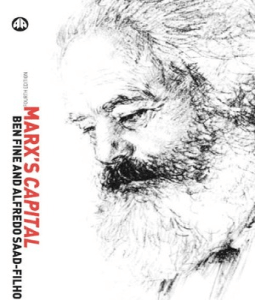-------------------------------------------------------------------------------  |
| [Source and Courtesy: Marx's Capital, Ben Fine and Saad Filho, Pg. 62, Figure 5.1] |
This post is a specific reflection on the above Diagram- Economic Reproduction in Capitalism[1], as depicted in the worth-studying book- Marx's Capital by Ben Fine and Alfredo Saad-Filho. This book is one of the most reliable introductions to all the four volumes of Marx's Capital. The above diagram shows, in essence, how economic activities- specific to capitalist mode of production[2], are reproduced, in simple[3] as well as expanded[4]
commodity production. More such commentaries on other concepts dealt in the book, shall be put in future.
Preliminary Observations:
Some important preliminary observations may be noted here-
1. The circuit above correctly brings out the geo-spatial motion of 'capital'. It necessarily presents a dynamic[5] view of the economy, which is constantly in motion.
2. The process of reproduction may be divided into two parts:
[A] Department 1(D1)- 'Means of Production' department: Thus, the lower half part of the circuit is D1.
 |
| [D1- Department 1, of means of production] |
 |
| [D2- Department 2, of means of consumption] |
3. The areas of circuit representing P1 and P2 depict the Production part of the entire process.
4. Consequently, the area representing 'Exchange' depicts that part of circuit wherein the sales and realization of commodities produced is done in the economy. In other words, it represents the market exchanges.
Some reflections:
'M' represents the total pool of money in the given economy. Looking at this model from a macro level will give a better understanding of how Marx's system analyzes the capitalist economy, giving an alternative view to other approaches. As we are analyzing two departments, D1 and D2,
M = m1 + m2
and also
M = m'1 + m'2
where, m1 = total money with the producers of D1, and m2 = total money with the producers of D2. At the end of the numerous transactions, entire amount, assuming zero savings, returns to the money pool M. This movement of money, to the extent it is capital advanced and then sales realized, is constant, disrupting frequently thought, and causing crisis[more on this in future posts].
The capitals advanced are:
for D1: c1+v1
for D2: c2+v2;
where, c1 and c2 are "constant capitals", and v1 and v2 are variable capitals[6].
The capitals- raw materials, etc.,[represented by C1 and C2 ] of respective departments flow within the economic unit of production- firm, pass through Production[P1 and P2], then get converted into commodities ready for sale[C'1 and C'2]. These are then sold, i.e. exchanged for money through market exchange.
The point of production is Profit. What if the same amount of Money M returns back in the hands of the owner? This would negate the entire purpose of production of commodities. Hence, it is very much essential for an excess amount to be received, which surpasses the original capital advanced. This, we call as per the model- m'1 and m'2 respectively for Departments 1 and 2.
m'1 in the model above is c1+v1+s1, m'2 is c2+v2+s2 respectively for their concerned departments. The mystery then is this 's'- surplus value. The orthodox belief will suggest that this surplus value- the amount excess to the original capital advanced[M1 and M2] has come through the market exchange. But as the model suggests, that's not the case. As soon as the production process is over- P1 and P2, we find the emergence of surplus values- s1 and s2. Hence, we have a mystery.
This mystery, we shall keep unsolved till future posts.
Notes and References:
1. Economic Reproduction means the constant generation/production of given social-economic conditions of production, and the production of commodities in a particular given manner, that reinforces the particular mode of production.
2. Capitalist mode of production may also be called, for the sake of simplicity- Capitalism.
3. Simple economic reproduction is wherein the surplus value produced- 's', is not ploughed back into production, but utilized for personal consumption.
4.Expanded reproduction is where this surplus value 's' is put into production of commodities[Goods or Services], which thus increases the pool of money 'M', every time this happens.
5. By dynamic, we mean an economy constantly in motion rather than a static version of it. This constant movement is seen in the national and global economy as a whole.
6. Variable capital here means the amount of money advanced as 'wages' to the workers[in any enterprise producing any commodity(goods or services)]. Constant capital means the amount of money put into raw materials, machines, tools , equipments, other expenditures, etc. These definitions are different than mainstream definitions.


